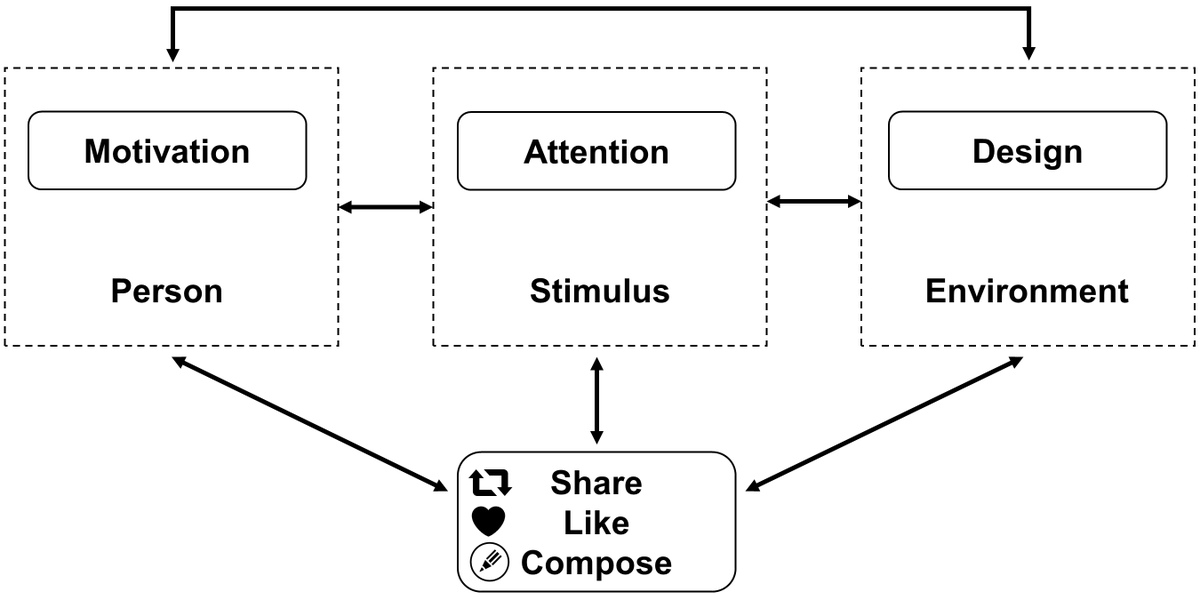
🚨New preprint! 🚨 In 2 observational social media studies (12.7 mil tweets) + 2 behavioral experiments (N=240) we examine how reinforcement and norm learning amplify moral #outrage expression on Twitter w/ @mollycrockett @killianmcl1 @tuanars123 (🧵👇) | psyarxiv.com/gf7t5/
We proposed that two design features of social media platforms interact with social learning mechanisms to impact outrage expression. First, we argued that streamlined social feedback delivery (e.g., salient + quantifiable likes/shares) leverages reinforcement learning 2/n 

At the same time, on the platforms users are organized in large networks where local norms of expression are highly salient b/c they are displayed in users’ news feeds. This design is very likely to tap into people’s tendency to learn from observation, i.e., norm learning 3/n 

We tested this empirically. We used supervised machine learning to build a moral outrage classifier trained on 26k tweets labeled for outrage expression. We collected full tweet histories (12M+ tweets) of more & less politically active users in 2 prereg observational studies 3/n
Before results, here are some caveats: not yet clear if findings generalize beyond Twitter platform or U.S. political context. Our classifier performs pretty well (F-1s > .70) but room for improvement with more training data. Beta testers welcome! (see below for more info) 5/n
Key finding 1: positive social feedback for outrage expressions associated with increased likelihood of future outrage expressions, consistent w principles of reinforcement learning. Small effect size but likely conservative estimate due to time-course of learning (see paper) 6/n
Key finding 2: Outrage expressions are strongly associated with expressive norms in users’ social networks, beyond users’ own preferences, suggesting that norm learning processes guide online outrage expressions. 7/n 

Interestingly, we also see interaction of social reinforcement and norm learning: users in more extreme networks where outrage is more normative may be less sensitive to social feedback. 8/n 

Two preregistered, confirmatory behavioral experiments used a mock Twitter environment to manipulate social feedback and norm perception. We replicate findings from observational studies and demonstrate causal influence of social feedback and norms on outrage expression 9/n 

Results suggest that interaction of psychology and tech design help explain moral behaviors on social media. Platforms are *not* neutral and neither are we; we come to platforms with ancient emotions shaped by small-group contexts (see also journals.sagepub.com/doi/abs/10.117…) 10/n
Our studies also showcase how studying psych processes on social media allows us to ask new questions: in our case, the organization of users in large networks allowed us to examine interaction of reinforcement and norm learning when they are typically studied separately 11/n
Open methods 🔓🧪 A beta version of the outrage classifier is available to academic researchers - feedback is welcome. For more info see: github.com/CrockettLab/ou… 12/n
We also include a lengthy SOM (link in preprint) that goes into extensive detail of our process of building a classifier by using psych theory and machine learning together; we hope it can serve as a useful guide for those interested in measuring psych constructs in text 13/n
• • •
Missing some Tweet in this thread? You can try to
force a refresh





